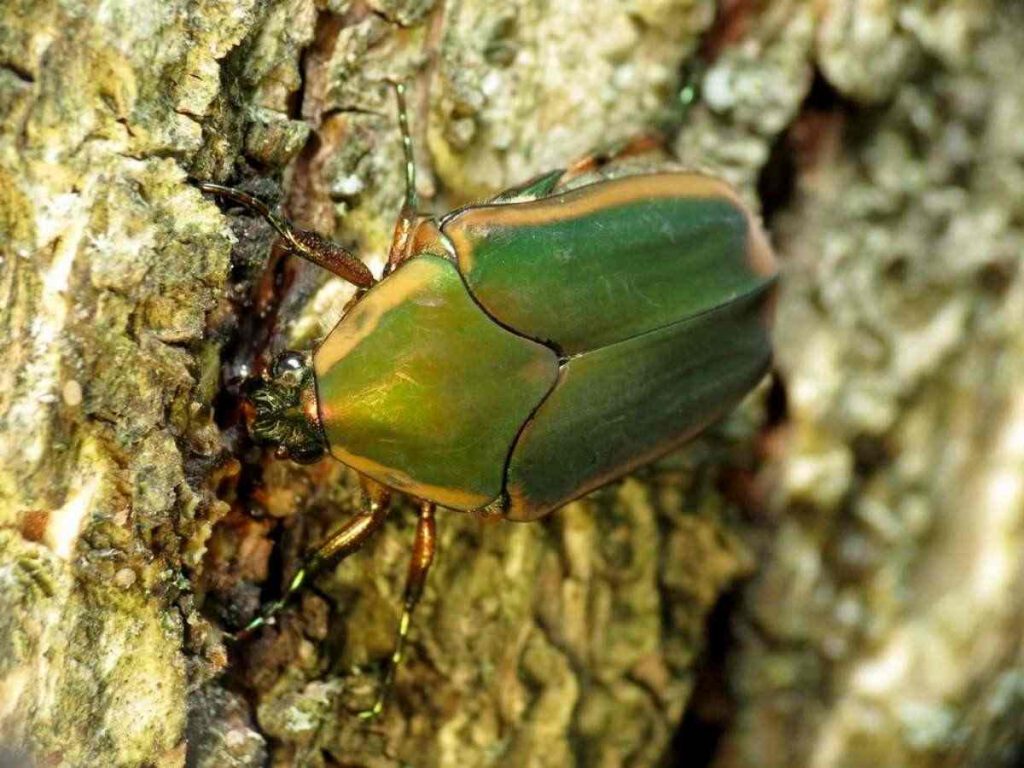Fig beetles (Cotinis mutabilis, also known as green fruit beetles or figeater beetles) are a common issue for many gardeners and homeowners who have planted Ficus trees over the last few decades. They can harm your plants and make them unappealing or even kill them altogether.
If you have fig beetles in your garden, don’t worry, it’s not too late to save the fruit.
Here’s How to Get Rid of Fig Beetles Naturally:
Using natural and non-toxic methods, such as: controlling them during the larval stage; removing their food sources; using physical barriers; hand-picking them; trapping them; feeding them to your cattle; you can get rid of them without using harmful chemicals in your garden.

What are fig beetles?
Fig beetles are a type of beetle that is known for eating the sweet nectar of fruits, petals, and pollen. They are similar in appearance to June bugs and other beetles and can often be confused with them.
Fig beetles are found throughout North America and are most commonly seen from May to September.
Why do fig beetles appear in the garden?
Fig beetles are attracted to two things: suitable shade and fruits, or sweet-smelling nectar. They usually hang out during the day in places with plenty of shade (trees, bushes). Because your garden usually provides both of these, there’s no reason why they WOULDN’T be attracted in the first place.
What attracts beetles?
Beetles are attracted to a variety of food sources, both plant and animal. They are attracted to food sources that are sweet and odorous. They will eat sap from cactus plants, fruit from trees, nectar or pollen from plants. They are also attracted to fruits, vegetables, and animal carcasses.
This means that gardeners need to be mindful of what they plant in their gardens as these beetles can do a lot of damage.
Unlike other beetles, they don’t seem to have any specific preferences in terms of what they eat-they’ll consume whatever is available to them. Therefore, green beetles may be lurking in your yard since you have fig trees or other fruit plants.
Fruits and vegetables: Many beetles are attracted to the sweetness of fruits and vegetables. This includes both fresh produce as well as things like overripe fruit that has fallen to the ground.
Nectar and Pollen: Nectar is a common food source for many types of insects, including bees and butterflies. Some beetles will also feed on pollen, especially if they are unable to find other food sources.
Animal carcasses: Carrion-feeding beetles are attracted to the smell of rotting flesh. These beetles will often lay their eggs in carcasses so that their larvae have a ready supply of food when they hatch.
6 natural ways to get rid of fig beetles
1.Prevention right in the larval stage
Fig beetles are most vulnerable in the larval stage. Therefore, this is an effective stage to help you prevent figeater beetle infestations.
Larvae typically overwinter beneath the bark of fruit plants. Additionally, you can find them living just below the soil’s surface, in close proximity to dead tree roots.
When the sap begins to flow again in the trees in the early spring, that’s usually when the figeater beetles make their way out of their larval stage and up the trees.
In the larval stage, fig eaters can be killed by applying a suffocating treatment that kills them at the larval stage of development. During the earliest stages of an infestation, this is crucial.
At this stage, larvae would also be found in decaying tree roots or bark at this stage, as well as beneath the soil’s surface. Debris that could provide shelter for these pests must be removed, as must the conditions that would attract them.
Other predators, like worms and flies, that feed on the larvae, might also aid in pest control.
2. Remove their food sources.
The simple way to prevent fig beetles in your garden is to eliminate their food source. You need to reduce the foods that attract beetles. We mentioned “what attracts fig beetles.” Also, prune your plants, removing spoiled fruit. Pick the ripe fruits; don’t let them ferment or overripen.
Fig beetle prevention by picking fruit every day, trimming tree branches near houses, keeping vegetation from touching windowsills or eaves; raking leaves, washing down outdoor furniture with a mild bleach solution before storing it for the winter.
To get rid of fig beetles, take away their food. This includes taking away any fruity plants and plants that aren’t needed.
3. Use physical barriers on your fruit trees and shrubs.
Physical barriers are objects that can be used to block or deter pests from accessing a particular area. This can be something as simple as a piece of cloth or netting placed over a plant, or a more permanent structure like a fence.
How to make a physical barrier?
You can make a physical barrier by using any material that will block pests from getting to your plants. This could be something as simple as placing netting over the top of your plants, or building a fence around them.
What type of physical barrier should I use?
The type of physical barrier you use will depend on the pests you are trying to keep out and the plants you are protecting. For example, if you are trying to keep out small insects, you might use fine mesh netting. If you are trying to protect larger plants from animals, you might use chicken wire or fencing.
The following are some examples of physical barriers:
The Cover for Floating Rows
Insect and bird netting
Also, you can use tree netting. You can buy tree netting at almost any store (Amazon, Walmart). They will help you prevent beetles and other pests effectively.
4. Hand-pick fig beetles
Look for them on the ground or on plants, often near fig trees. They are attracted to light, so you may find them near doors or windows.
How to remove them:
Pick them off by hand and drop them into a bucket of soapy water. You can also use a vacuum cleaner to suck them up.
Pour them into your compost or toss them in the bin and dispose of them safely.
5. Make a bottle trap to lure fig beetles.
– A 2-liter soda bottle
– A knife
-Some fruit juice, honey, or beer
Instructions:
1. Cut the top off of the 2-liter soda bottle, and then cut the bottom off as well. You should now have a long tube.
2. Make sure that the tube is clean, and then pour in your fruit juice, honey, or beer until it’s about an inch from the top of the tube.
3. Place the tube outside near where you’ve seen fig beetles, and make sure that the opening is pointing downwards so that they can crawl in but not out.
4. Check your trap every day or so, and empty it out when it gets full.
6. Feed them to your birds and chickens.
Fig beetles are the favorite food of chickens and other birds. Using the “ABC” method mentioned above, compress them for your chickens and birds to eat.
Chickens are also experts at composting. So let them peck and scratch through your compost mulch for beetles and worms. This helps you get rid of the beetles in the first place, and the chickens are well fed.
How do fig beetles reproduce?
The adults lay their eggs in the flowers of the fig tree. When the eggs hatch, the larvae burrow into the fruit of the tree and feed on it. When they are ready to pupate, they burrow back out of the fruit and spin a cocoon in which they transform into adults.
The adult beetles then emerge from their cocoons and mate. The cycle then starts all over again!
Interestingly, fig beetles reproduce in a very unique way. Adult fig beetles deposit their eggs in the soil between 6 and 8 inches (15 and 20 cm) deep in late summer. After about two weeks, the eggs hatch, and the young feed on soil organic matter until the next winter.
The grubs, which are about the size of a thumb, feed on the roots and thatch of grass and emerge from their burrows on warm days in late winter and early spring.
The fig beetle has a very interesting reproductive cycle.
How can you prevent a fig beetle infestation?
1. Inspect your plants regularly for signs of infestation and remove any beetles you find.
2. Prune your trees to promote good air circulation and discourage beetles’ hiding places.
3. Apply a registered insecticide to your fig trees as directed on the label.
Prevention tips:
1. Keep weeds and debris around your fig trees clear to reduce the potential for beetles’ hiding places.
2. Plant trap crops such as radishes or nasturtiums near your fig trees to attract beetles away from them.
What are the natural predators of fig beetles?
Birds are one of the most common predators of fig beetles. They will typically eat the beetle whole, including the hard shell. Some of the most common bird species that will eat fig beetles are bluebirds, robins, and swallows.
Lizards:
Lizards are another common predator of fig beetles. They will usually eat the beetle whole, including the hard shell. Some of the most common lizard species that will eat fig beetles include geckos and skinks.
Frogs:
Frogs are also a common predator of fig beetles. They will typically eat the beetle whole, including the hard shell. Some of the most common frog species that will eat fig beetles include bullfrogs and green frogs.
Insects:
Insects are also known to prey on fig beetles. The most common insects that eat fig beetles are ants, wasps, and bees. These insects will typically bite off the head of the beetle and then feast on the body.
More things to know about fig beetles
Where do fig beetles come from?
Fig beetles are a type of beetle that is native to moister areas of the American southwest and areas of Mexico. They are attracted to fig trees, which is where they get their name. They have also been found in other parts of the world, including Australia and Europe.
With more people cultivating their own food and using natural materials like compost and mulch, their distribution has grown substantially since the 1960s. This has led to them increasing their range and beginning to appear in coastal Southern California.
What do fig beetles look like?
They have a metallic dark green on top and a tan-colored band edging their forewings (known as elytra). Additionally, they have iridescent green legs and undersides.
In addition, fig beetles have characteristic markings that can help identify them. They have six legs and a pair of antennae. The insect’s underbelly, seen from behind, is a lighter brown or orangey tint.
These particular beetles can both roll over on their backs and walk backwards. The green has a glossy finish and a slight sheen, making it quite reflective. Their legs and stomach areas are also coated in the iridescent green coloration.
Fig beetles are giant beetles that are about 1.25 inches when fully matured. The most recognizable and obvious phenotype is the shiny green shield on its back.
What is the life cycle of a fig beetle?
The life cycle of fig beetles (also known as green fruit beetles) is relatively simple and is very comparable to the life cycles of a great number of other species of beetles. The different parts of its life cycle are called eggs, larvae, pupae, and adults, in that order.
Eggs: The female fig beetle will lay her eggs on the underside of leaves near the midrib. The eggs are small, oval, and yellow in color.
Larvae: Once the eggs hatch, the larvae will feed on the leaves for about two weeks before pupating. The larvae are small, white, and have a black head.
Pupae: The pupae are white and about the size of an adult fig beetle. They will emerge from their cocoons in about two weeks.
Adults: The adults are black with yellow stripes and about half an inch long. They will mate and lay eggs soon after emerging from their cocoons.
What do fig beetles eat?
Fig beetles prefer fruit trees and will eat the figs when they’re ripe. The figeater beetle’s diet consists mainly of fruits and vegetables, but they prefer sweet food, which includes the leaves, flowers, and saps of some plants as well as ripe or overripe fruit.
The adult fig beetles eat a variety of food sources, as listed above. Some common ones include organic mulch, manure, compost piles, sap, fruits (both fresh and overripe), cacti, grass or plant roots, orchard plants, sweet foods like sugar or syrup, fermented fruit, and so on. They will also feed on leaf debris and ripe fruit that is lying on the ground.
Fig beetles can eat up to 50% of their body weight per day.
Where do fig beetles live?
The main habitats of fig beetles are in the southwestern United States and some areas in Mexico. They are also found in both Australia and Europe. Their range has grown a lot, and now they live in the eastern United States and along the coast of Southern California.
How big is a fig beetle?
Fig beetles are about 1/2 inch to 3/4 inch long. They are black with a green or bronze sheen. The wing covers have ridges that give them a saw-toothed appearance. Fig beetles have a round or oval shape.
Fig beetles are often confused with June bugs or Japanese beetles. However, fig beetles are smaller and their wing covers have ridges, while June bugs and Japanese beetles do not.
Are fig beetles poisonous?
In general, fig beetles are harmless. They are considered friendly and useful beetles for urban ecosystems. In some cities, they are also considered beneficial insects because they help in the consumption of rotting fruit. In addition, fig beetles are completely harmless to humans.
Although beetles are not harmful to humans, that doesn’t mean you can’t carelessly touch them because beetles can spread bacteria because they crawl on things and can pass bacteria through their feet. Please handle with gloves and wash your hands after.
You will also feel uncomfortable when you see figeater beetles flying freely in your garden with their buzzing. In larger quantities, this will cause worse feelings.
Do fig beetles bite or sting?
The answer is no. Not like some other bugs. The fig beetle is not known to bite or sting humans. There is no danger to humans posed by the fig beetle.
Are fig beetles invasive?
An invasive species is a plant, animal, or other organism that is not native to a particular area and that has a tendency to spread. Invasive species can cause serious damage to the environment, economy, and human health.
How do fig beetles compare to other invasive species?
Fig beetles are not as aggressive as some other invasive species, but they can still cause significant damage. They are most likely to impact crops and gardens, but they can also infest homes and other structures.
Potential impacts of fig beetles include: reducing crop yields, damaging fruits and vegetables, spreading disease, and causing financial losses for farmers and homeowners.
Do fig beetles fly?
Fig beetles use their strong wings to fly short distances in search of food or mates. They are not particularly good flyers, and often crash into objects while in flight.
How far do they fly?
Fig beetles can fly up to several hundred feet in a single flight. However, they usually only fly short distances, and most flights are less than 50 feet.
How often do they fly?
Fig beetles typically only take to the air when they need to travel from one place to another in search of food or mates. They do not spend much time flying, and most of their time is spent crawling around on the ground.
Are fig beetles blind?
Fig beetles are not blind. Many people confuse this because they often see them crashing into walls and even people. In fact, they are slow and poor flyers.







